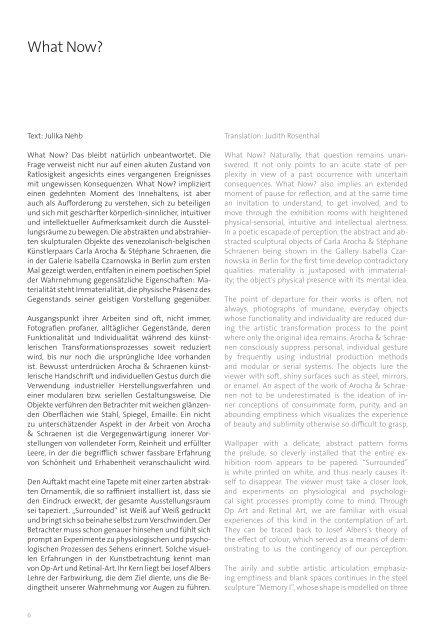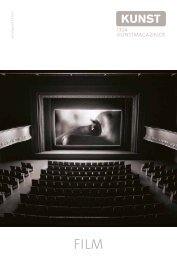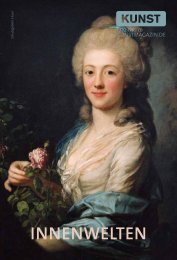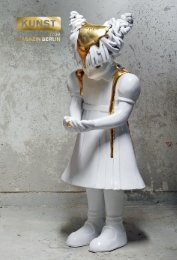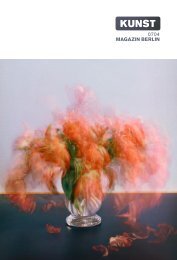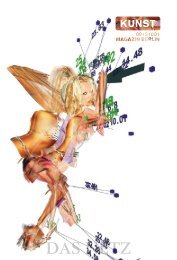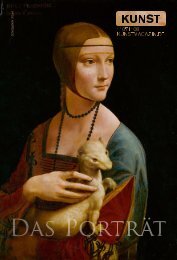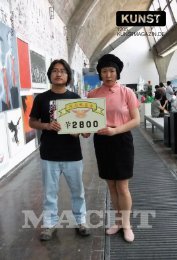Download als .pdf - KUNST Magazin
Download als .pdf - KUNST Magazin
Download als .pdf - KUNST Magazin
Sie wollen auch ein ePaper? Erhöhen Sie die Reichweite Ihrer Titel.
YUMPU macht aus Druck-PDFs automatisch weboptimierte ePaper, die Google liebt.
What Now?<br />
Text: Julika Nehb<br />
What Now? Das bleibt natürlich unbeantwortet. Die<br />
Frage verweist nicht nur auf einen akuten Zustand von<br />
Ratlosigkeit angesichts eines vergangenen Ereignisses<br />
mit ungewissen Konsequenzen. What Now? impliziert<br />
einen gedehnten Moment des Innehaltens, ist aber<br />
auch <strong>als</strong> Aufforderung zu verstehen, sich zu beteiligen<br />
und sich mit geschärfter körperlich-sinnlicher, intuitiver<br />
und intellektueller Aufmerksamkeit durch die Ausstellungsräume<br />
zu bewegen. Die abstrakten und abstrahierten<br />
skulpturalen Objekte des venezolanisch-belgischen<br />
Künstlerpaars Carla Arocha & Stéphane Schraenen, die<br />
in der Galerie Isabella Czarnowska in Berlin zum ersten<br />
Mal gezeigt werden, entfalten in einem poetischen Spiel<br />
der Wahrnehmung gegensätzliche Eigenschaften: Materialität<br />
steht Immaterialität, die physische Präsenz des<br />
Gegenstands seiner geistigen Vorstellung gegenüber.<br />
Ausgangspunkt ihrer Arbeiten sind oft, nicht immer,<br />
Fotografien profaner, alltäglicher Gegenstände, deren<br />
Funktionalität und Individualität während des künstlerischen<br />
Transformationsprozesses soweit reduziert<br />
wird, bis nur noch die ursprüngliche Idee vorhanden<br />
ist. Bewusst unterdrücken Arocha & Schraenen künstlerische<br />
Handschrift und individuellen Gestus durch die<br />
Verwendung industrieller Herstellungsverfahren und<br />
einer modularen bzw. seriellen Gestaltungsweise. Die<br />
Objekte verführen den Betrachter mit weichen glänzenden<br />
Oberflächen wie Stahl, Spiegel, Emaille: Ein nicht<br />
zu unterschätzender Aspekt in der Arbeit von Arocha<br />
& Schraenen ist die Vergegenwärtigung innerer Vorstellungen<br />
von vollendeter Form, Reinheit und erfüllter<br />
Leere, in der die begrifflich schwer fassbare Erfahrung<br />
von Schönheit und Erhabenheit veranschaulicht wird.<br />
Den Auftakt macht eine Tapete mit einer zarten abstrakten<br />
Ornamentik, die so raffiniert installiert ist, dass sie<br />
den Eindruck erweckt, der gesamte Ausstellungsraum<br />
sei tapeziert. „Surrounded“ ist Weiß auf Weiß gedruckt<br />
und bringt sich so beinahe selbst zum Verschwinden. Der<br />
Betrachter muss schon genauer hinsehen und fühlt sich<br />
prompt an Experimente zu physiologischen und psychologischen<br />
Prozessen des Sehens erinnert. Solche visuellen<br />
Erfahrungen in der Kunstbetrachtung kennt man<br />
von Op-Art und Retinal-Art. Ihr Kern liegt bei Josef Albers<br />
Lehre der Farbwirkung, die dem Ziel diente, uns die Bedingtheit<br />
unserer Wahrnehmung vor Augen zu führen.<br />
Translation: Judith Rosenthal<br />
What Now? Naturally, that question remains unanswered.<br />
It not only points to an acute state of perplexity<br />
in view of a past occurrence with uncertain<br />
consequences. What Now? <strong>als</strong>o implies an extended<br />
moment of pause for reflection, and at the same time<br />
an invitation to understand, to get involved, and to<br />
move through the exhibition rooms with heightened<br />
physical-sensorial, intuitive and intellectual alertness.<br />
In a poetic escapade of perception, the abstract and abstracted<br />
sculptural objects of Carla Arocha & Stéphane<br />
Schraenen being shown in the Gallery Isabella Czarnowska<br />
in Berlin for the first time develop contradictory<br />
qualities: materiality is juxtaposed with immateriality;<br />
the object’s physical presence with its mental idea.<br />
The point of departure for their works is often, not<br />
always, photographs of mundane, everyday objects<br />
whose functionality and individuality are reduced during<br />
the artistic transformation process to the point<br />
where only the original idea remains. Arocha & Schraenen<br />
consciously suppress personal, individual gesture<br />
by frequently using industrial production methods<br />
and modular or serial systems. The objects lure the<br />
viewer with soft, shiny surfaces such as steel, mirrors,<br />
or enamel. An aspect of the work of Arocha & Schraenen<br />
not to be underestimated is the ideation of inner<br />
conceptions of consummate form, purity, and an<br />
abounding emptiness which visualizes the experience<br />
of beauty and sublimity otherwise so difficult to grasp.<br />
Wallpaper with a delicate, abstract pattern forms<br />
the prelude, so cleverly installed that the entire exhibition<br />
room appears to be papered. “Surrounded”<br />
is white printed on white, and thus nearly causes itself<br />
to disappear. The viewer must take a closer look,<br />
and experiments on physiological and psychological<br />
sight processes promptly come to mind. Through<br />
Op Art and Retinal Art, we are familiar with visual<br />
experiences of this kind in the contemplation of art.<br />
They can be traced back to Josef Albers’s theory of<br />
the effect of colour, which served as a means of demonstrating<br />
to us the contingency of our perception.<br />
The airily and subtle artistic articulation emphasizing<br />
emptiness and blank spaces continues in the steel<br />
sculpture “Memory I”, whose shape is modelled on three<br />
Die luftig-subtile künstlerische Artikulation, die Leere<br />
und Leerstellen betont, setzt sich in der Stahlskulptur<br />
„Memory I“ 1 fort, deren Gestalt drei einfachen Reg<strong>als</strong>keletten<br />
nachempfunden ist. Diese stehen jedoch nicht<br />
etwa an einer Wand, sondern liegen teils verbogen und<br />
übereinander arrangiert auf dem Boden. Zwangsläufig<br />
fragt man sich weshalb, tritt näher heran – und begegnet<br />
zunächst sich selbst. Die Oberflächen von „Memory I“ sind<br />
verspiegelt. Klassischerweise suggerieren Spiegel eine<br />
Ausdehnung des Raumes; doch Arocha & Schraenen<br />
destabilisieren den Raum und lassen ihn und alles, was<br />
sich in der Oberfläche spiegelt, in den vielfach gebrochenen<br />
Flächen der Skulptur verschwinden. Das Verlangen<br />
des Betrachters, sich seiner selbst zu vergewissern, wird<br />
durch die Gestalt des Objekts unterbunden. Spiegel tauchen<br />
immer wieder im Werk von Arocha & Schraenen<br />
auf. Damit setzen sie künstlerische Strategien aus den<br />
späten 1960er-Jahren fort, <strong>als</strong> sich Spiegel zur Oberfläche<br />
par excellence entwickelten. 2 Die Illusion von Leere<br />
oder Transparenz des Spiegels steht in Kontrast zu seiner<br />
massiven Materialität; „Memory I“ wirkt fast schwerelos.<br />
1 Als Vorbild für die Arbeit diente eine Fotografie von drei deformierten<br />
Regalen auf den Straßen New Yorks nach dem Hurrikan Sandy; das<br />
Künstlerpaar hatte sich zu dieser Zeit dort aufgehalten.<br />
2 „Mirror, Mirror. Then and Now“, Curated by Ann Stephen, ex. cat.,<br />
publ. by Insitute of Modern Art, University of Sydney, 2010, S.5 ff. U.a.<br />
Robert Morris, Joseph Kosuth, Ian Burn, Heinz Mack, Robert Smithson.<br />
Carla Arocha and Stéphane Schraenen: Memory I, 2013, Steel and glass mirror / Stahl, Spiegel, 135 x 300 x 165 cm<br />
Courtesy: Galerie Isabella Czarnowska, Berlin © Pieter Huybrechts<br />
simple shelf structures. They do not stand against a wall,<br />
however, but are arranged on the floor one on top of the<br />
other, partially bent out of shape. Inevitably, we ask ourselves<br />
why, move closer to the work, and encounter …<br />
ourselves. The surfaces of “Memory I” 1 are mirrored. Mirrors<br />
classically suggest an extension of space. Arocha &<br />
Schraenen, however, destabilize space, and have it – and<br />
everything reflected in the work’s exterior – disappear<br />
in the multiply fractured surfaces of the sculpture. The<br />
viewer’s desire to assure herself of himself is thwarted<br />
by the object’s shape. Mirrors turn up again and again<br />
in the Arocha & Schraenen oeuvre. With them, the duo<br />
pursues artistic strategies of the late 1960s when mirrors<br />
developed to become the surface par excellence. 2<br />
The illusion of a mirror’s emptiness or transparency contrasts<br />
with its massive materiality; “Memory I” makes<br />
an almost weightless impression. Naturally, the work’s<br />
title initially seems to allude to direct memory of the<br />
kind experienced in the encounter with the second large<br />
sculpture (“Memory II”): in a sense, the visual experience<br />
seems to repeat itself in the exact duplicate of “Memory I”<br />
– whose surfaces, however, are not mirrored but matt.<br />
1 The work was modelled on a photograph of three contorted shelves lying<br />
on the streets of New York after Hurricane Sandy; the two artists were in<br />
the city at the time the hurricane struck.<br />
2 Mirror, Mirror: Then and Now, curated by Ann Stephen, exh. cat. published<br />
by Institute of Modern Art, University of Sydney, 2010, pp. 5ff. Artists such<br />
as Robert Morris, Joseph Kosuth, Ian Burn, Heinz Mack or Robert Smithson.<br />
6<br />
7


